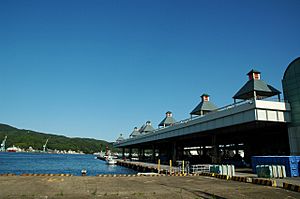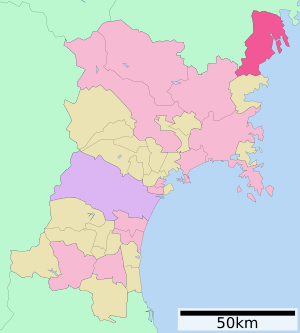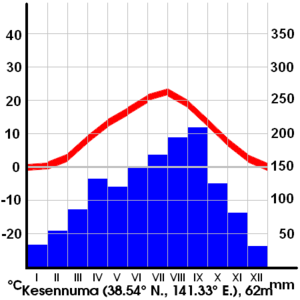Kesennuma facts for kids
Quick facts for kids
Kesennuma
気仙沼市
|
|||||||||||||||
|---|---|---|---|---|---|---|---|---|---|---|---|---|---|---|---|

Kesennuma Fishing Port
|
|||||||||||||||
|
|||||||||||||||

Location of Kesennuma in Miyagi Prefecture
|
|||||||||||||||
| Country | Japan | ||||||||||||||
| Region | Tōhoku | ||||||||||||||
| Prefecture | Miyagi | ||||||||||||||
| Area | |||||||||||||||
| • Total | 332.44 km2 (128.36 sq mi) | ||||||||||||||
| Population
(July 1, 2022)
|
|||||||||||||||
| • Total | 58,982 | ||||||||||||||
| • Density | 177.421/km2 (459.520/sq mi) | ||||||||||||||
| Time zone | UTC+9 (Japan Standard Time) | ||||||||||||||
| Phone number | 0226-22-6600 | ||||||||||||||
| Address | 1-1-1 Yōka-machi, Kesennuma-shi 988-8501 | ||||||||||||||
| Climate | Cfa | ||||||||||||||
|
|||||||||||||||
Kesennuma (気仙沼市, Kesennuma-shi) is a city located in Miyagi Prefecture, Japan. It's known for its beautiful coastline and important fishing port. As of August 2020, about 59,803 people lived there in 26,390 households. The city covers an area of 332.44 square kilometers (128.36 sq mi).
Kesennuma faced a huge challenge on March 11, 2011. A powerful earthquake and tsunami caused a lot of damage. Many parts of the city were destroyed, and major fires broke out. Despite this, the city has been working hard to rebuild and recover.
Contents
Exploring Kesennuma's Geography
Kesennuma is in the far northeastern part of Miyagi Prefecture. It's built around the western side of Kesennuma Bay. The city also includes the island of Ōshima. Its coastline is very unique, with many deep inlets called rias. This area is part of the Sanriku Fukkō National Park. This park stretches all the way north to Aomori Prefecture.
Where Kesennuma is Located
To the east, Kesennuma faces Hirota Bay, Kesennuma Bay, and the Pacific Ocean. To the south, it borders Minamisanriku, Miyagi. The rest of its borders are with Iwate Prefecture. This includes the city of Ichinoseki to the west. To the north, it borders the city of Rikuzentakata.
The highest point in Kesennuma is Mount Ōmori, which is 711.9 meters (2,336 ft) tall. The lowest point is at sea level, right by the ocean. The Ō River flows through the city and empties into Kesennuma Bay.
Nearby Cities and Towns
Kesennuma shares borders with several other places:
- In Iwate Prefecture:
* Minamisanriku * Tome
Kesennuma's Climate and Weather
Kesennuma has a humid subtropical climate. This means it has mild summers and cold winters. The average temperature each year is about 11.2°C (52.2°F). September is usually the wettest month, with an average of 184.3 mm (7.26 in) of rain.
The warmest month is August, with an average temperature of about 22.9°C (73.2°F). January is the coldest month, with an average of about 0.3°C (32.5°F). The highest temperature ever recorded in Kesennuma was 36.7°C (98.1°F) in July 2011. The lowest was -12.6°C (9.3°F) in February 1980.
Understanding Kesennuma's Population
Over the last 40 years, the number of people living in Kesennuma has slowly decreased.
| Historical population | ||
|---|---|---|
| Year | Pop. | ±% |
| 1920 | 43,824 | — |
| 1930 | 55,209 | +26.0% |
| 1940 | 63,653 | +15.3% |
| 1950 | 76,391 | +20.0% |
| 1960 | 84,110 | +10.1% |
| 1970 | 87,914 | +4.5% |
| 1980 | 92,246 | +4.9% |
| 1990 | 88,152 | −4.4% |
| 2000 | 82,394 | −6.5% |
| 2010 | 73,489 | −10.8% |
| 2020 | 61,147 | −16.8% |
A Look at Kesennuma's History
The area where Kesennuma is today has a long history. It was part of an old province called Mutsu Province. People have lived here since at least the Jōmon period, which was thousands of years ago. This is known because of old shell middens found along the coast. These are piles of shells left by ancient people.
Later, during the Heian period, the Northern Fujiwara family ruled this area. During the Sengoku period, different samurai families fought for control. Eventually, the Date clan from Sendai Domain took over during the Edo period. This was under the Tokugawa shogunate.
How Kesennuma Became a City
The town of Kesennuma was officially created on June 1, 1889. This happened when Japan set up its modern system of towns and villages. Kesennuma became a city on June 1, 1953. At that time, it joined with the nearby town of Shishiori and the village of Matsuiwa. Later, in 1955, it also added the villages of Niitsuki, Hashikami, and Oshima. More recently, in 2006 and 2009, the towns of Karakuwa and Motoyoshi also became part of Kesennuma.
The 2011 Tsunami and Recovery
On March 11, 2011, a massive tsunami hit Kesennuma. This followed a very strong earthquake. Large parts of the city were destroyed. The island of Ōshima, part of Kesennuma, was cut off because ferry connections were damaged. Fuel from fishing boats spilled and caught fire, burning for four days. This was a very difficult time for the city.
After the disaster, there was a fishing boat, the Kyotoku Maru No 18, that had been swept far inland. Some people wanted to keep it as a monument to the tsunami. But in August 2013, residents decided to scrap the boat.
In 2014, Kesennuma was given a special title. It became Japan's first "slow town". This means it focuses on a relaxed pace of life and local culture.
Kesennuma's Economy: Fishing and More
Kesennuma's economy relies heavily on tourism and commercial fishing. The city is especially famous for its fishing port. It's known for catching shark, tuna, pacific saury, and skipjack tuna. Before the 2011 disaster, Kesennuma was Japan's busiest port for processing bonito and swordfish. Today, fishing and related businesses provide about 85% of the jobs in the city.
Learning in Kesennuma: Schools
Kesennuma has many schools for young people. The city government runs 14 public elementary schools and eight junior high schools. The Miyagi Prefectural Board of Education operates four public high schools. There is also one private high school. In addition, the prefectural government runs one special education school.
Getting Around Kesennuma: Transportation
Railway Services
![]() East Japan Railway Company (JR East) - Kesennuma Line
East Japan Railway Company (JR East) - Kesennuma Line
- The train operations on this line were stopped after the 2011 disaster. They have been replaced by a BRT (Bus Rapid Transit) system.
- Stations: Kurauchi - Rikuzen-Koizumi - Motoyoshi - Koganezawa - Ōya-Kaigan - Rikuzen-Hashikami - Saichi - Matsuiwa - Minami-Kesennuma - Fudōnosawa - Kesennuma
![]() East Japan Railway Company (JR East) - Ōfunato Line
East Japan Railway Company (JR East) - Ōfunato Line
- Like the Kesennuma Line, train operations here were also stopped and replaced by a BRT system.
- Stations: Kesennuma - Shishiori-Karakuwa - Kami-Shishiori
Major Highways
 National Route 45
National Route 45 National Route 284
National Route 284 National Route 346
National Route 346
Kesennuma's Sister Cities
Kesennuma has special connections with other cities around the world and within Japan. These are called "sister cities" or "friendship relations."
International Connections
 Puntarenas, Costa Rica
Puntarenas, Costa Rica Zhoushan, Zhejiang Province, China
Zhoushan, Zhejiang Province, China Changyi District, Jilin, China
Changyi District, Jilin, China Friendship relation with Ports of Kesennuma and Seattle, Washington, United States
Friendship relation with Ports of Kesennuma and Seattle, Washington, United States
Japanese Sister Cities
 Ichinoseki, Iwate, Japan
Ichinoseki, Iwate, Japan Murone, Iwate, Japan
Murone, Iwate, Japan
Famous People from Kesennuma
Many talented people come from Kesennuma, including:
- Isshin Chiba, a voice actor
- Satoru Kanemura, a professional baseball player
- Tetsuo Kanno, a politician
- Shinji Maggy, a comedian and magician
- Itsunori Onodera, a politician
- Rikako Sasaki, an idol singer
See also
 In Spanish: Kesennuma (Miyagi) para niños
In Spanish: Kesennuma (Miyagi) para niños





